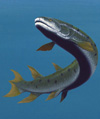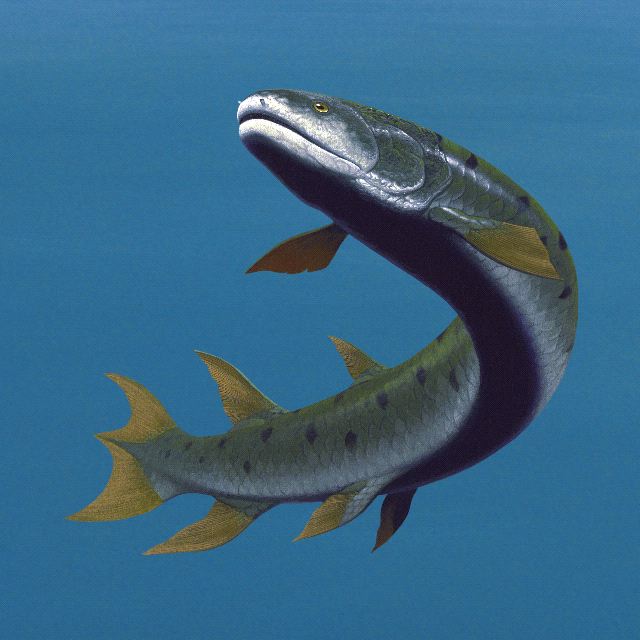Osteolepiforms
Of all the extinct sarcopterygians, the osteolepiforms are probably the best known.
 (48 kb) Highly diversified during the Devonian, they include some stars of paleoichthyology, including Osteolepis with its long streamlined body, large median fins and epicercal tail, and Eusthenopteron, which reached more than a metre long and sported a three-pointed symmetrical tail. More than any other species, Eusthenopteron provided paleontologists with the most information about this group.
(48 kb) Highly diversified during the Devonian, they include some stars of paleoichthyology, including Osteolepis with its long streamlined body, large median fins and epicercal tail, and Eusthenopteron, which reached more than a metre long and sported a three-pointed symmetrical tail. More than any other species, Eusthenopteron provided paleontologists with the most information about this group.
The osteolepiform shape, and by deduction their way of life, is sometimes compared to that of the modern day pike. Long and slender, with posterior fins set far back and a long mouth lined with strong teeth, these fish were without a doubt quick and efficient predators. Their skull moved in a peculiar manner and included an intracranial joint that allowed for a very large gape.
Osteolepiforms had single nasal openings on either side of their head, both of which were attached to a large opening in the animal’s palate. This orifice is equivalent to the choana in primitive tetrapods, a feature that enabled tetrapods to breathe through their nostrils with their mouth closed.
The structure of the humerus is very similar to the humerus in basal tetrapods, despite having a different shape. In most osteolepiforms, the base of the paired and median fins was adorned on both sides by a large, thickened scale known as the basal scute.
Appearing in the Middle Devonian, osteolepiforms survived the extinction at the end of the Devonian, only to be wiped out at the beginning of the Permian. The famous osteolepiform Eusthenopteron, along with its lesser known cousin Callistiopterus, are found in the cliffs at Miguasha.

 (48 kb) Highly diversified during the Devonian, they include some stars of paleoichthyology, including Osteolepis with its long streamlined body, large median fins and epicercal tail, and Eusthenopteron, which reached more than a metre long and sported a three-pointed symmetrical tail. More than any other species, Eusthenopteron provided paleontologists with the most information about this group.
(48 kb) Highly diversified during the Devonian, they include some stars of paleoichthyology, including Osteolepis with its long streamlined body, large median fins and epicercal tail, and Eusthenopteron, which reached more than a metre long and sported a three-pointed symmetrical tail. More than any other species, Eusthenopteron provided paleontologists with the most information about this group.The osteolepiform shape, and by deduction their way of life, is sometimes compared to that of the modern day pike. Long and slender, with posterior fins set far back and a long mouth lined with strong teeth, these fish were without a doubt quick and efficient predators. Their skull moved in a peculiar manner and included an intracranial joint that allowed for a very large gape.
Osteolepiforms had single nasal openings on either side of their head, both of which were attached to a large opening in the animal’s palate. This orifice is equivalent to the choana in primitive tetrapods, a feature that enabled tetrapods to breathe through their nostrils with their mouth closed.
The structure of the humerus is very similar to the humerus in basal tetrapods, despite having a different shape. In most osteolepiforms, the base of the paired and median fins was adorned on both sides by a large, thickened scale known as the basal scute.
Appearing in the Middle Devonian, osteolepiforms survived the extinction at the end of the Devonian, only to be wiped out at the beginning of the Permian. The famous osteolepiform Eusthenopteron, along with its lesser known cousin Callistiopterus, are found in the cliffs at Miguasha.
Site map | Feedback | Links | Sources | Credits
Osteolepiforms
<< Fleurantia | Callistiopterus >>



